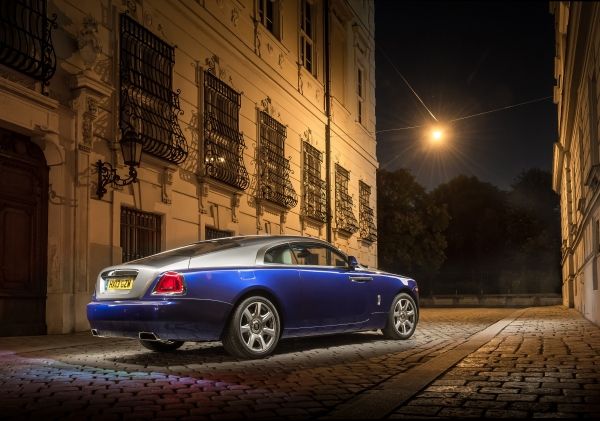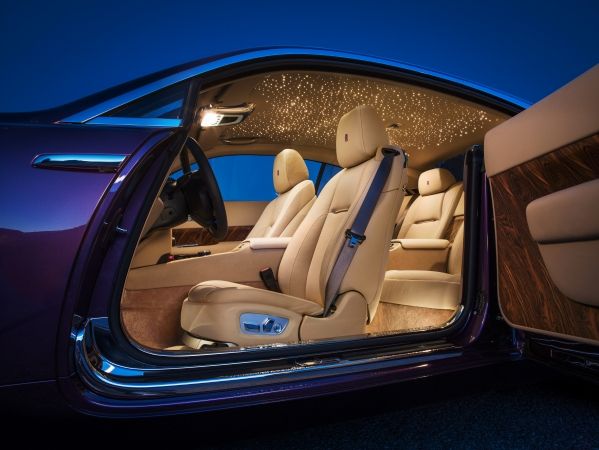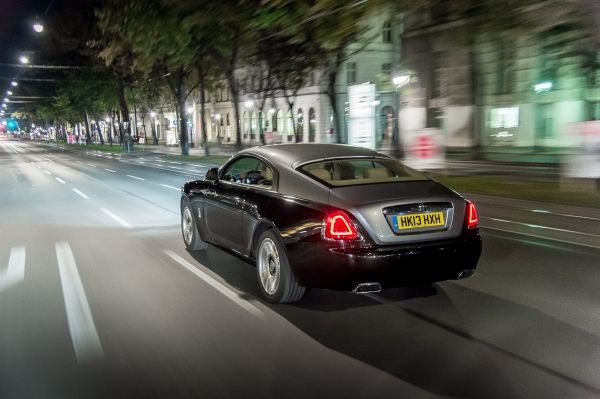Rolls-Royce Wraith Review

Rolls-Royce Wraith ’s sweeping fastback gives the car its unique character. Bold lines, tension in the panels and a raked rear screen evoke the image of an athlete poised in the starting blocks. Further expression of dynamic intent can be seen in Wraith’s deeply recessed grille and wide rear track.
Coach doors open to reveal a sumptuous interior complete with softest Phantom-grade leathers and expanses of wood. Named after the famous cove in the South of France where Sir Henry Royce and his design and engineering teams spent their winters, the Canadel finish sweeps through the contemporary interior, cosseting four occupants in a space bathed in light and warmth.
The interior ambiance is complemented by Starlight Headliner, a Bespoke feature available beyond Phantom family cars for the first time. 1,340 fibre optic lamps are hand-woven into the roof lining to give the impression of a glittering, starry night sky.
A twin-turbocharged V12 engine married to 8-speed automatic ZF transmission ensure that power delivery is effortless, but dramatic. 624 bhp is available to the driver while the 0-60 mph sprint is achieved in 4.4 seconds, compared with 563 bhp and 0-60 in 4.7 seconds for Ghost.
From 1,500 rpm 590 ft lbs of torque available, a wide rear track, shorter wheelbase and lower roof height further underwrite Wraith as the most powerful, involved driving experience of any Rolls-Royce in history. Performance delivers as the car’s suspension has been tuned to minimize body roll and discreetly amplify feedback when cornering; while steering weight is heavier at high speeds and lighter at low speeds to give a more polished and spirited drive.

However, Wraith is no GT bruiser. Agility improvements have been achieved with absolutely no compromise to the sensation of riding on a bed of air. Furthermore, the debut of Satellite Aided Transmission technology takes the powertrain to a new level of effortless delivery, one that perfectly suits the Rolls-Royce brand.
Satellite Aided Transmission uses GPS data to read the road ahead. It sees beyond what the driver sees; anticipates his next move based on location and current driving style, then selects the most appropriate gear for the terrain ahead. Corners, motorway junctions and roundabouts are all anticipated meaning Wraith is constantly poised to deliver on its promise of performance.
A more polished, effortless driving experience and even better response brings a new even more dynamic dimension to the famous Rolls-Royce trait, waftability.
For over a century a Rolls-Royce motor car has featured technologies designed to support occupants discreetly, delivering a peerless driving experience epitomised by the term ‘effortlessness’. In every Rolls-Royce these assist the driver when called upon, but are prepared to return without fuss to the background when no longer required.
Advances in mechanical and electrical technology deliver systems like head-up display, adaptive headlights and Wraith’s keyless opening boot. But improvements in connectivity have taken the human-machine interface to a new level of sophistication, a suite of aids that could be likened to a contemporary on-board valet.

Voice activation commands, for example, come with a one-touch call button located on the steering wheel. A destination no longer requires manual input from a navigation menu and route assistance begins immediately, on-screen and via audio guidance following a voice command such as “navigate to Fifth Avenue in New York City.”
Additional improvements in communications come in the design and functionality of the elegant Spirit of Ecstasy Rotary Controller. This allows navigation through on-screen functions using a touch pad that features pinch and pull functionality to echo smart phone usage. Letters can also be ‘drawn’ onto the pad by hand rather than by scrolling through a series of available characters on-screen.




